HP Unveils Spectre: The World’s Thinnest Laptop
by Anton Shilov on April 5, 2016 11:59 AM EST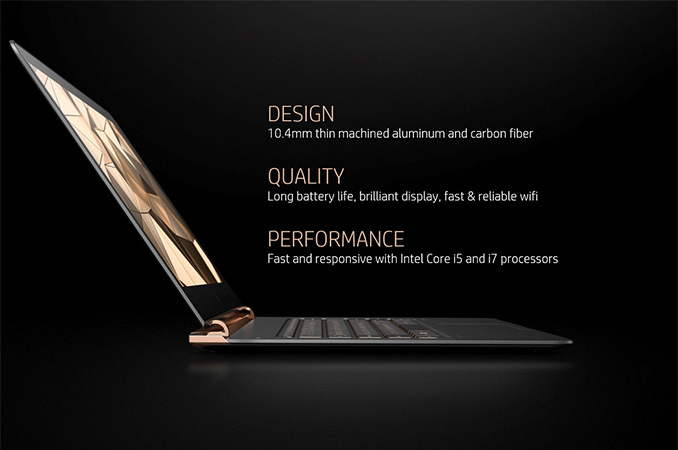
HP has announced its new Spectre laptop - the world’s thinnest 13.3” notebook. Despite its miniature size, the Spectre uses Intel’s Core i5/i7 microprocessor, a PCIe-based SSD, a full-size keyboard as well as an advanced audio system developed by Bang & Olufsen. To build its new notebook, HP had to use a number of innovative technologies, although to make the system so small and thin it had to sacrifice upgradeability and serviceability. On top of it all, the HP Spectre comes across as very price competitive.
The HP Spectre is just 10.4 mm thick and weighs 1.10 kilograms (2.45 lbs). To build it, HP had to use CNC-machined anodized aluminum and combine it with carbon fiber, a custom display panel with Gorilla Glass 4 as well as special recessed piston hinges. To maximize battery life (which is officially listed at 9 hours 30 minutes), HP had to use two types of batteries of different shapes inside its Spectre laptop, giving four cells in total. As part of a premium line, it comes in black and gold finish as well as with a different varient of HP’s logo, emphasizing the position of the system.
The HP Spectre laptop is based on the Core i5-6200U (two cores with Hyper-Threading, 3 MB L3 cache, Intel HD Graphics 520) or the Core i7-6500U (two cores with Hyper-Threading, 4 MB L3 cache, Intel HD Graphics 520), but the manufacturer does not disclose exact clock-rates of the CPUs. HP notes that the microprocessors may not necessarily work at their default frequencies all the time, but indicates that the chips are still considerably faster than the Core M processors used inside the Apple MacBook. These could either be the full fat 15W parts, or the models could be in cTDP down mode.
| Comparison of Ultra-Thin Notebooks | ||||
| HP Spectre | Apple MacBook (2015) | ASUS UX305UA | ||
| Screen Resolution | 1920×1080 | 2304×1440 | 1920×1080 3200×1800 |
|
| CPU | Intel Core i5-6200U Intel Core i7-6500U |
Intel Core M 1.1 GHz Intel Core M 1.2 GHz Intel Core M 1.3 GHz |
Intel Core i3-6100U Intel Core i5-6200U Intel Core i7-6500U |
|
| Graphics | Intel HD Graphics 520 (24 execution units) |
Intel HD Graphics 5300 (24 EUs) | Intel HD Graphics 520 (24 execution units) |
|
| RAM | 8 GB (LPDDR3?) | 8 GB LPDDR3 | 4 GB LPDDR3 8 GB LPDDR3 |
|
| Storage | 256 GB SSD 512 GB SSD |
256 GB SSD 512 GB SSD |
128 GB SSD 256 GB SSD 512 GB SSD |
|
| Wi-Fi | Wi-Fi | 802.11ac Wi-Fi | 802.11ac Wi-Fi | |
| USB | 3.1 | 3 × Type-C | - | - |
| 3.0 | - | 1 × Type-C | 2 × Type-A | |
| 2.0 | - | - | 1 × Type-A | |
| Thunderbolt | 2 × Thunderbolt 3 | - | - | |
| HDMI | - | - | micro-HDMI | |
| Other I/O | Microphone, stereo speakers, audio jack | |||
| Thickness | 10.4 mm | up to 13.1 mm | 16 mm | |
| Weight | 1.10 kilograms | 0.92 kilograms | 1.30 kilograms | |
| Price | 256GB: $1170 (Core i5) $1250 (Core i7) |
256GB: $1300 (1.1 GHz) $1600 (1.3 GHz) |
$750 - $1200 | |
To cool-down the CPUs, HP uses its so-called 'hyperbaric cooling technology', which features two ultra-thin fans, a heat-pipe as well as a special copper radiator. The fans intake cool air from the outside and create significant air pressure inside the chassis to blow away hot air. The company does not disclose how loud such cooling system is, but implies that noise levels created by the Spectre should be comfortable.
The Spectre is equipped with 8 GB of memory (we believe LPDDR3) that is soldered to the motherboard, which means that it cannot be upgraded. The notebook is also equipped with a standard 256 GB or 512 GB SSD, but HP does not release performance figures or which model this is. The company also says that since the design of its laptop is “sealed”, it is impossible to upgrade the storage drive at home, suggesting a soldered down version of an M.2 drive. Keeping in mind that it is impossible to add storage to the majority of tablets and 2-in-1 hybrid PCs, it is not surprising that HP chose to limit upgrade capabilities of its Spectre notebook. When creating Spectre, HP focused mostly on making an extremely thin design, but not to offer capabilities for further modernization.
Due to thin design and relatively limited battery capacity of the HP Spectre, the manufacturer did not have much choice when it comes to display panels. HP uses a 13.3” full-HD (1920×1080) IPS panel with 300 nits brightness, which covers 72% NTSC. According to HP, the panel provides the right balance between resolution, power consumption, the brightness, and the price. Nevertheless, the most important feature of the panel is its thinness. The whole display assembly is just 2 mm thick.
The HP Spectre also comes with three USB type-C ports, two of which support Thunderbolt 3. These will be powered by Intel's Alpine Ridge controller, though HP has not disclosed how many are in use (either one controller for both ports, or two controllers for one each). The TB3-enabled ports can be used to connect external displays as well as Thunderbolt 3 peripherals. It is noteworthy that since HP does not talk about connecting things like external graphics adapters to its Spectre notebooks, this feature may not be enabled right now.
The notebook is also equipped with a keyboard that has 1.3 mm travel as well as a trackpad with full-travel etched glass. HP compares it Spectre to Apple’s MacBook and claims that the keyboard, as well as the touchpad of the MacBook, are less comfortable to use than those on the HP machine, something that needs to be verified by independent reviews.
Communication capabilities of the HP Spectre include a Wi-Fi and Bluetooth module that supports 2.4 GHz and 5 GHz networks. The module supports only one “slot” antenna, therefore, its performance may be lower when compared to other modern notebooks, another thing that HP may have had to sacrifice for portability. HP also does not specify if the Wi-Fi is 802.11ac or 802.11n only.
This month HP will begin to sell its Spectre laptop at hp.com as well as at Best Buy in the U.S. The Spectre based on the Intel Core i5-6200U and equipped with 8 GB of RAM and 256 GB SSD will cost $1169.99, whereas the model featuring the Intel Core i7-6500U, 8 GB of memory and a 256 GB SSD will be priced at $1249.99. There is no word on the cost of the 512GB models as of yet, although we expect another $100-$150 on top of that. In May, the manufacturer plans to start selling its thinnest laptop in other countries, but it does not reveal the list of countries or recommended prices. In the US, HP will also offer limited edition systems co-developed with famous designers combining a golden finish and Swarovski crystals. In addition, the company will also sell accessories (a Bluetooth mouse, a carry bag and a leather sleeve) that match the design of the Spectre notebook.
Source: HP


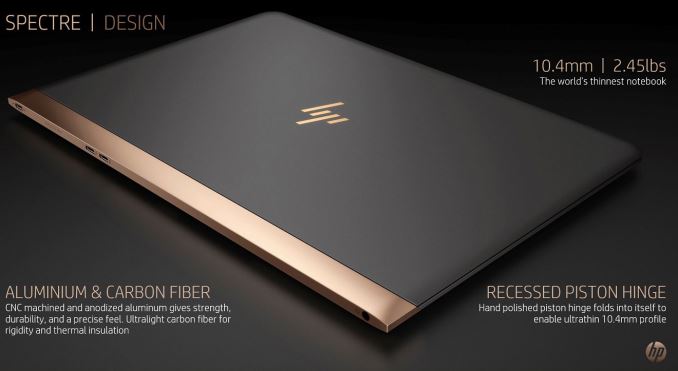
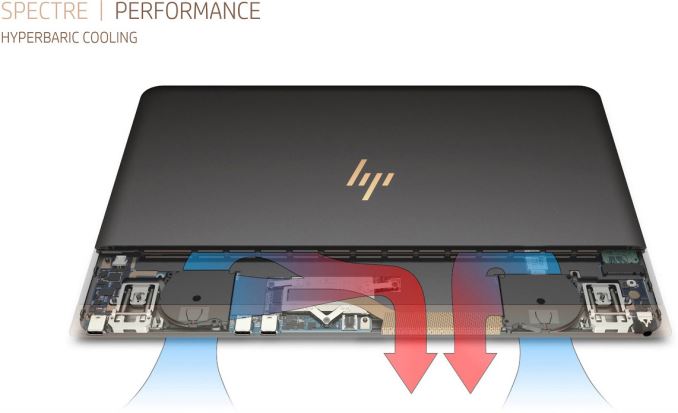
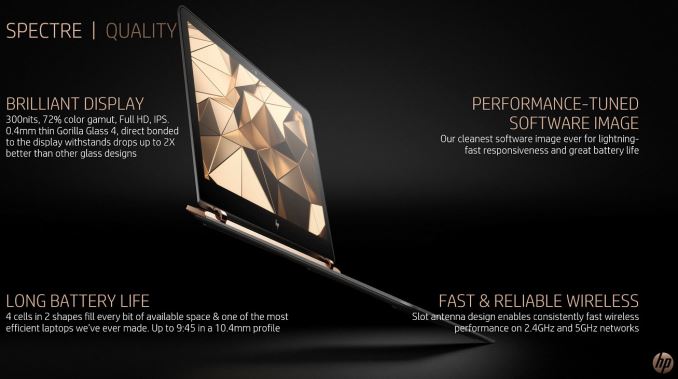
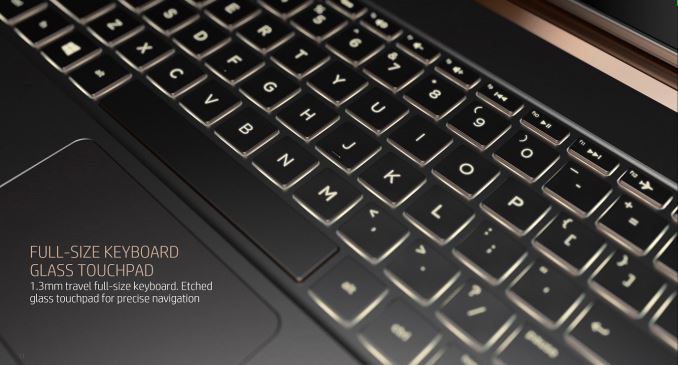









75 Comments
View All Comments
Speedfriend - Wednesday, April 6, 2016 - link
Could agree more, once you have had a laptop with touchscreen, you cant go back. Browsing long website is so much easier flicking the screen to scroll, as well as looking at photos and being able to swipe and zoom with your fingers.zepi - Wednesday, April 6, 2016 - link
Maybe it is just the complete incapability of MS / Synaptics / OEM to actually make the scrolling experience decent on windows-touchpad. MS used for years to treat touchpads as mice, making it impossible to offer proper scrolling support.Personally I prefer very much scrolling with apple-touchpads.
I guess it might be better if you get modern Windows with Precision Touchpad, but unfortunately my corporate laptop is still stuck with win7.
SteelRing - Tuesday, April 5, 2016 - link
I bought my Spectre x360 refurb last July and I couldn't be happier and this is looking a lot better suited for tablet use than mine (old was was 3+ lbs). If the fan is anything like mine, it gets really loud like a plane trying to take off when CPU load is high, but if you're using it just for office use it's likely the fan will never turn on, but the aluminum chassis do get warm since it works as a passive heatsink. Mine came with DP and HDMI ports, which I will sorely miss in this new one but that's the price for being too thin I suppose.Meteor2 - Tuesday, April 5, 2016 - link
Converters give you those ports back.3x USB-C, two providing Thunderbolt 3, is awesome.
stanleyipkiss - Tuesday, April 5, 2016 - link
It looks chintzy.chaos215bar2 - Tuesday, April 5, 2016 - link
"HP has announced its new Spectre laptop - the world’s thinnest 13.3” notebook. Despite its miniature size, the Spectre uses Intel’s Core i5/i7 microprocessor, a PCIe-based SSD, a full-size keyboard as well as an advanced audio system developed by Bang & Olufsen. To build its new notebook, HP had to use a number of innovative technologies, although to make the system so small and thin it had to sacrifice upgradeability and serviceability. On top of it all, the HP Spectre comes across as very price competitive."I don’t usually like to nitpick, but this whole opening strikes me as a bit weird.
First, Core i5/i7 and SSD is pretty much assumed for this kind of laptop. I guess Core i3 would be an option, but this spec alone (without noting _which_ core i5/i7 they use) doesn’t imply much at all about size or performance. The full-size keyboard is certainly notable, but that’s about it. An “advanced audio system developed by Bang & Olufsen” is pure marketing speak, and repeating it without any additional qualification brings into question the quality of any commentary in the rest of the piece.
Moving on, I would certainly assume this kind of computer sacrifices upgradeability and serviceability to achieve it’s size, but that’s not a good thing despite what the last sentence implies by transitioning with “on top of it all” (unless being price competitive is a bad thing). I might overlook this elsewhere, but it’s a pretty glaring error in the intro.
These are minor details on their own, but taken as a whole are examples of a trend I’ve noticed on AnandTech over the past year or so. I came to AnandTech in the past primarily for the in-depth hardware analysis, and lately most pieces read more like press releases than actual hardware reviews. Obviously a product announcement piece like this won’t get any in-depth analysis, but you can do better than simply repeating specs and HP’s marketing.
voicequal - Tuesday, April 5, 2016 - link
The i5/i7 is significant as one would expect the slower Core M to be used in such a power/heat constrained chassis. The PCIe SSD indicates high end storage vice SATA SSD, although the performance is much more gated by the flash type (3D MLC, 2D MLC, 2D TLC) than the interface. I do suspect the audio is pure marketing.Daniel Egger - Tuesday, April 5, 2016 - link
There're plenty of devices in the same weight class with Core-i7, like Dell XPS 13, Toshiba Portege, Asus Zenbook... All without fully sacrificing the serviceability...Meteor2 - Tuesday, April 5, 2016 - link
There's a world of difference between 'just' a SSD and a PCIe SSD.Daniel Egger - Tuesday, April 5, 2016 - link
Not for power and size constraint SSDs, that's still the same order of magnitude. The problem is: For a laptop the small plus in performance really doesn't matter and the NVMe protocol might add a few funny issues. In fact I'd rather have a good "old" fashioned mSATA SSD in a Windows machine...